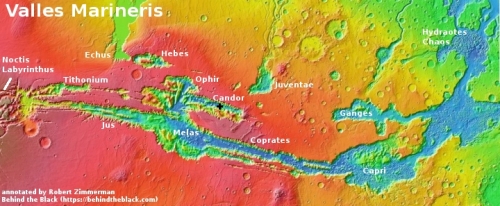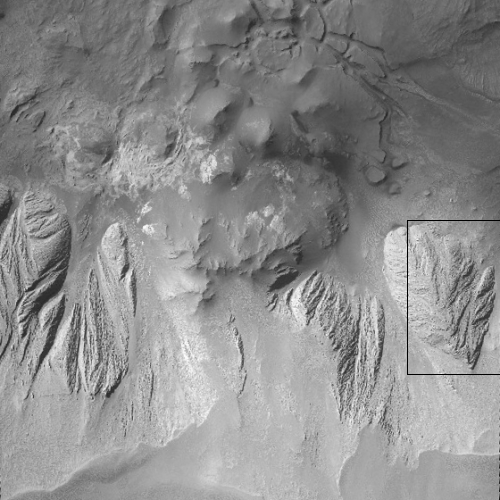A volcanic extrusion on the floor of Valles Marineris?
Cool image time! The photo to the right, rotated, cropped, and reduced to post here, was taken on August 31, 2021 by the high resolution camera on Mars Reconnaissance Orbiter (MRO). It shows what the science team labels a “possible contact between two units.”
I think that contact is the point where that eroded mountain touches the surrounding smooth canyon floor. The mountain itself looks to me to be a very eroded extrusion of lava that was placed there from below a very very long time ago, covered later by material, and now exposed for a long enough period that its surface appears to have been carved by wind and even possibly flowing water or ice.
Because it is lava it is more resistant to erosion, which is why it sits higher than the smooth terrain around it. Even though both experienced the same processes of wear over time, the mountain’s surface was only carved away partly, while the material that had been in the floor was washed away entirely.
This is all a guess. However, a look below at the overview map, showing this mountain’s location on Mars, as well as MRO’s wider view from its context camera, I think strengthens my hypothesis.

The black cross in Candor Chasma marks the location of this mountain, on the floor of one of Valles Marineris’ side canyons.
The context camera image below shows that this extrusion is not alone, but part of a series that parallel a higher cliff to the south. The flow lines on all the extrusions are generally to the north-south, suggesting flows in that direction. However, that flow direction is perpendicular to the canyon’s overall trend to the east-west, which is a puzzle.
Note what appear to be giant mud cracks to the north of these extrusions, lower in the canyon floor. These suggest that water or ice was once prevalent here, but is now gone. The canyon is in the Martian equatorial regions, so for it to be dry is expected. The surface though does suggest that once ice and water were present, and caused some of the erosion we see.
The flow lines also seem to suggest that a major flood had flowed down from that southern cliff and poured over these extrusions, carving away at there shapes. If made of lava this would explain why they were only partially eroded.
At least, that’s my theory. I am willing to bet I am wrong, but I also know that more information will be needed to find out what is right.
On Christmas Eve 1968 three Americans became the first humans to visit another world. What they did to celebrate was unexpected and profound, and will be remembered throughout all human history. Genesis: the Story of Apollo 8, Robert Zimmerman's classic history of humanity's first journey to another world, tells that story, and it is now available as both an ebook and an audiobook, both with a foreword by Valerie Anders and a new introduction by Robert Zimmerman.
The print edition can be purchased at Amazon or from any other book seller. If you want an autographed copy the price is $60 for the hardback and $45 for the paperback, plus $8 shipping for each. Go here for purchasing details. The ebook is available everywhere for $5.99 (before discount) at amazon, or direct from my ebook publisher, ebookit. If you buy it from ebookit you don't support the big tech companies and the author gets a bigger cut much sooner.
The audiobook is also available at all these vendors, and is also free with a 30-day trial membership to Audible.
"Not simply about one mission, [Genesis] is also the history of America's quest for the moon... Zimmerman has done a masterful job of tying disparate events together into a solid account of one of America's greatest human triumphs."--San Antonio Express-News
Cool image time! The photo to the right, rotated, cropped, and reduced to post here, was taken on August 31, 2021 by the high resolution camera on Mars Reconnaissance Orbiter (MRO). It shows what the science team labels a “possible contact between two units.”
I think that contact is the point where that eroded mountain touches the surrounding smooth canyon floor. The mountain itself looks to me to be a very eroded extrusion of lava that was placed there from below a very very long time ago, covered later by material, and now exposed for a long enough period that its surface appears to have been carved by wind and even possibly flowing water or ice.
Because it is lava it is more resistant to erosion, which is why it sits higher than the smooth terrain around it. Even though both experienced the same processes of wear over time, the mountain’s surface was only carved away partly, while the material that had been in the floor was washed away entirely.
This is all a guess. However, a look below at the overview map, showing this mountain’s location on Mars, as well as MRO’s wider view from its context camera, I think strengthens my hypothesis.

The black cross in Candor Chasma marks the location of this mountain, on the floor of one of Valles Marineris’ side canyons.
The context camera image below shows that this extrusion is not alone, but part of a series that parallel a higher cliff to the south. The flow lines on all the extrusions are generally to the north-south, suggesting flows in that direction. However, that flow direction is perpendicular to the canyon’s overall trend to the east-west, which is a puzzle.
Note what appear to be giant mud cracks to the north of these extrusions, lower in the canyon floor. These suggest that water or ice was once prevalent here, but is now gone. The canyon is in the Martian equatorial regions, so for it to be dry is expected. The surface though does suggest that once ice and water were present, and caused some of the erosion we see.
The flow lines also seem to suggest that a major flood had flowed down from that southern cliff and poured over these extrusions, carving away at there shapes. If made of lava this would explain why they were only partially eroded.
At least, that’s my theory. I am willing to bet I am wrong, but I also know that more information will be needed to find out what is right.
On Christmas Eve 1968 three Americans became the first humans to visit another world. What they did to celebrate was unexpected and profound, and will be remembered throughout all human history. Genesis: the Story of Apollo 8, Robert Zimmerman's classic history of humanity's first journey to another world, tells that story, and it is now available as both an ebook and an audiobook, both with a foreword by Valerie Anders and a new introduction by Robert Zimmerman.
The print edition can be purchased at Amazon or from any other book seller. If you want an autographed copy the price is $60 for the hardback and $45 for the paperback, plus $8 shipping for each. Go here for purchasing details. The ebook is available everywhere for $5.99 (before discount) at amazon, or direct from my ebook publisher, ebookit. If you buy it from ebookit you don't support the big tech companies and the author gets a bigger cut much sooner.
The audiobook is also available at all these vendors, and is also free with a 30-day trial membership to Audible.
"Not simply about one mission, [Genesis] is also the history of America's quest for the moon... Zimmerman has done a masterful job of tying disparate events together into a solid account of one of America's greatest human triumphs."--San Antonio Express-News



